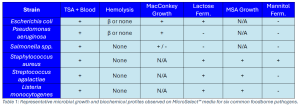MicroSelect™: A Smart, Integrated Solution for Microbial Preselection
Introduction
In microbiology laboratories, preselecting bacterial strains typically requires multiple plates, workflows, and materials. This process is often time-consuming, costly, and prone to error. MicroSelect™ addresses these challenges with a hybrid tri-compartment Petri dish that combines three of the most commonly used selective and differential media: TSA with 5% sheep blood, MacConkey agar, and Mannitol Salt Agar (MSA). The result is a streamlined workflow that supports visual identification of key bacterial traits in a single incubation, while reducing resource use and laboratory waste.
MicroSelect™ is intended for application in academic, clinical, and food safety laboratories, where it can be incorporated into standard microbiological workflows without requiring major procedural modification. Whether for training students, screening foodborne pathogens, or supporting rapid diagnostics, the MicroSelect platform provides clarity, reliability, and operational efficiency. Its ready-to-use format and compatibility with AI-supported workflows make it especially suitable for labs modernizing their microbiology processes.
Culture Media
TSA + 5% Sheep Blood
The TSA + 5% Sheep Blood compartment provides a rich, non-selective medium capable of supporting the growth of a wide range of organisms. It allows users to identify hemolytic activity, which is useful in differentiating species such as Streptococcus pyogenes (beta-hemolytic), Streptococcus pneumoniae (alpha-hemolytic), or Enterococcus faecalis (non-hemolytic).
MacConkey Agar
MacConkey Agar is a selective medium designed to isolate Gram-negative enteric bacteria and differentiate them based on lactose fermentation. Lactose fermenters like Escherichia coli appear as pink colonies, while non-fermenters such as Salmonella or Pseudomonas produce colorless colonies.
Mannitol Salt Agar (MSA)
Mannitol Salt Agar (MSA) is a selective medium that supports the growth of halotolerant organisms such as staphylococci. It differentiates species based on their ability to ferment mannitol. Staphylococcus aureus turns the medium yellow, while Staphylococcus epidermidis leaves it pink or red.

The Case for Switching to MicroSelect™
Traditional methods require multiple plates, which increase handling time and the risk of contamination. MicroSelect™ consolidates three tests into one compact format, reducing the complexity of sample processing and documentation. In addition, it provides immediate visual cues across media types, simplifying interpretation and recordkeeping.
MicroSelect™ also supports AI-driven analysis and image-based workflows. Because results are visible in distinct compartments, the format is ideal for training models to automate pre-classification of common bacterial traits. This offers future-proof compatibility with digital microbiology systems and remote lab teaching platforms.
Laboratories using MicroSelect™ can expect significant cost reductions. A lab testing 100 isolates per month stands to save over $7,500 annually by cutting down on media consumption, labor, and waste disposal. The plates are manufactured in Ottawa, Canada, further lowering the carbon footprint compared to imported alternatives. As an added benefit, proceeds from academic sales support internships and applied research placements for local students.
Technical Specifications
Each MicroSelect™ plate measures 100 mm in diameter and includes three separate compartments pre-filled with TSA + 5% Sheep Blood, MacConkey Agar, and Mannitol Salt Agar. The plates are sterile and ready to use upon arrival. They should be stored between 2–8°C and used within 6 months from the manufacturing date. The design is compatible with most incubators and colony counters.
Applications
MicroSelect™ is a versatile solution designed to support diverse microbiological workflows. In academic laboratories, it offers students a hands-on platform to learn about selective and differential media in a simplified, all-in-one format. In clinical microbiology, it helps streamline preliminary screening of pathogens by consolidating common tests into a single plate. Food safety labs benefit from its ability to detect and differentiate common contaminants with minimal handling, aiding regulatory testing and quality control. For research institutions, MicroSelect™ provides a consistent and efficient platform for studying microbial diversity, antibiotic resistance, and bioinformatics training.
Across all settings, its cost-effectiveness and compatibility with modern imaging workflows make it an ideal choice for institutions seeking to improve microbiology throughput while maintaining high standards of reliability and traceability.
References
- Truant, A.L. (ed.). 2002. Manual of Commercial Methods in Clinical Microbiology. American Society for Microbiology.
- Tille, P. 2014. Bailey and Scott’s Diagnostic Microbiology (13th edition).
- Gerhardt, P., R.G.E. Murray, W.A. Wood and N.R. Krieg. Methods for General and Molecular Bacteriology. ASM Press.
- MacFaddin, J.F. 1985. Media for Isolation-Cultivation-Identification-Maintenance of Medical Bacteria. Vol. 1.
- European Pharmacopoeia 6.5 (2009). 2.6.13 Microbiological examination of non-sterile products: Test for specified
- microorganisms.
- United States Pharmacopoeia 32 NF 27 (2009). <62> Microbiological examination of non-sterile products: Test for specified microorganisms.
- Japanese Pharmacopoeia 4.05 (2008). Microbiological examination of non-sterile products: Test for specified microorganisms.
To request a sample, or find out more, visit us at https://bioeureka.com/
CLICK HERE TO DOWNLOAD THE WHITE PAPER!
Contact us today:
Devien Durbano,
Microbiologist, Lead Scientist, Bioeureka
Canada & USA: +1-613-614-6323
©2025 Technologie Bioeureka Inc. All rights reserved.



